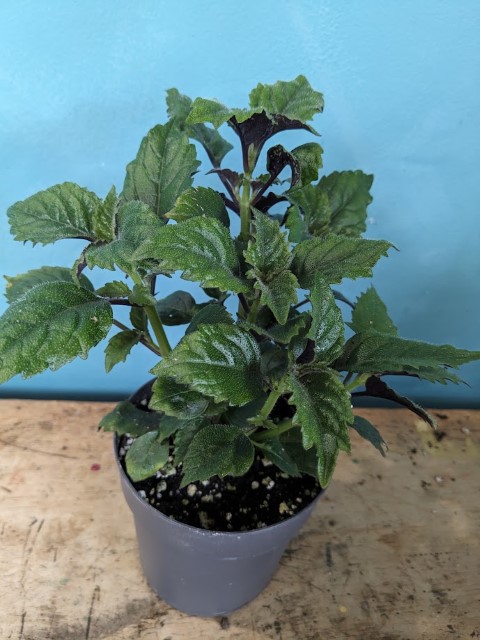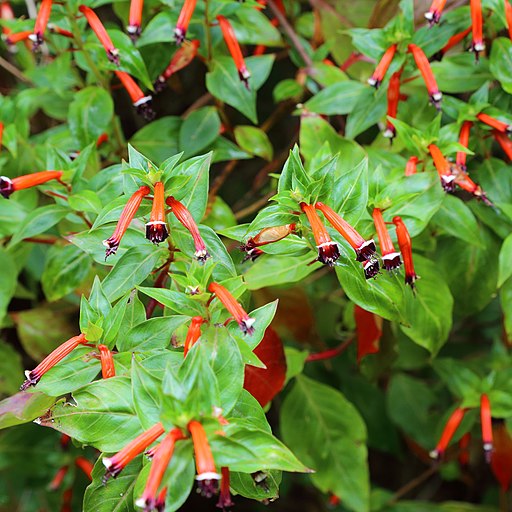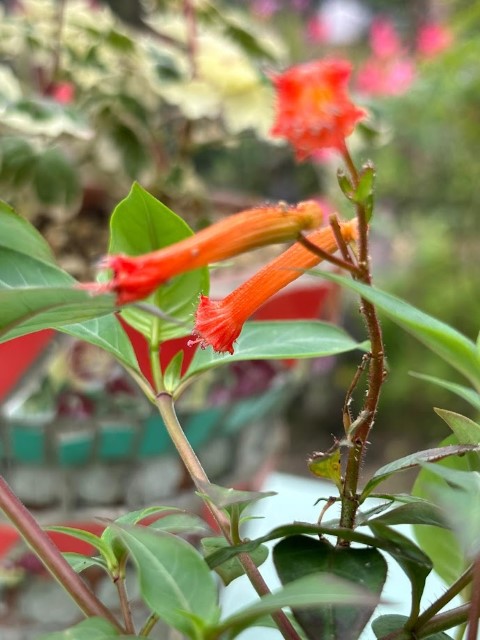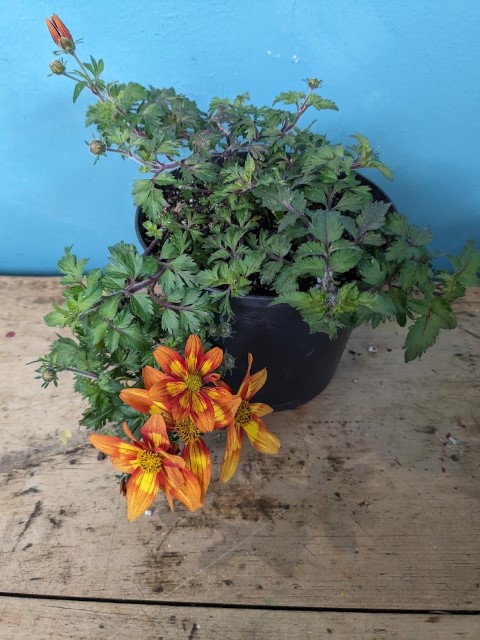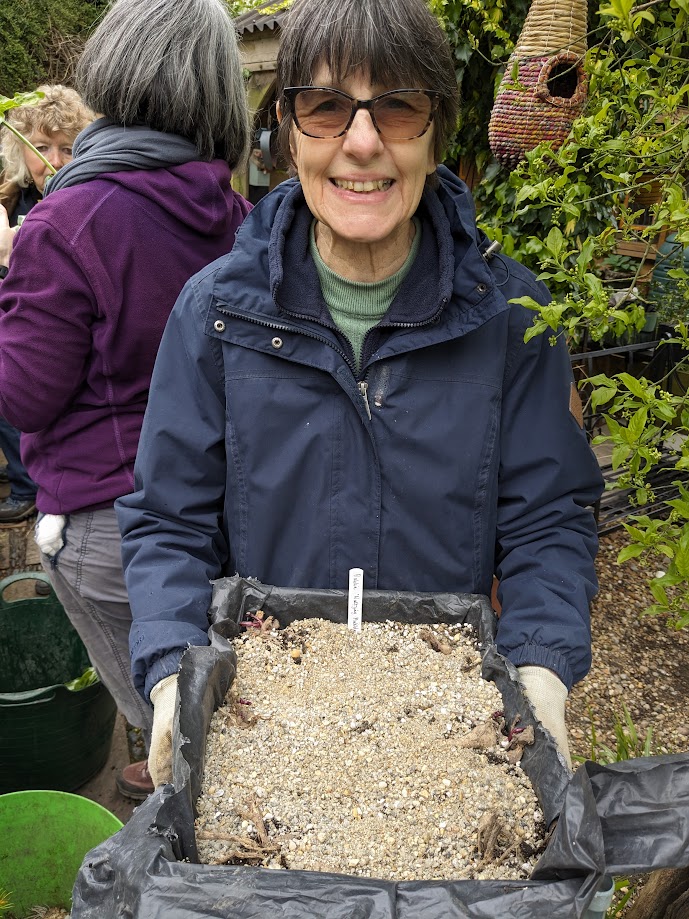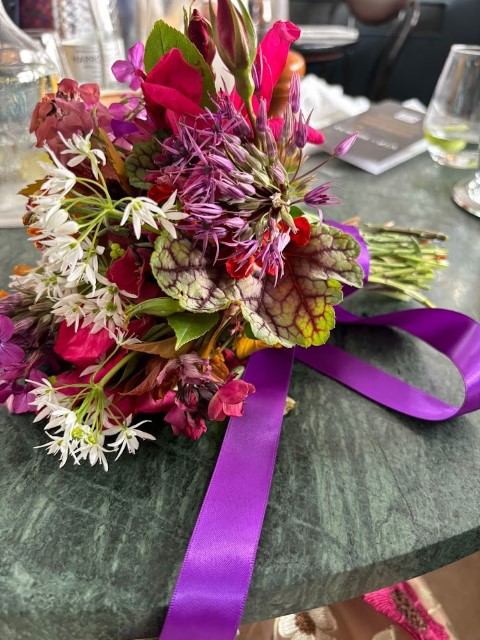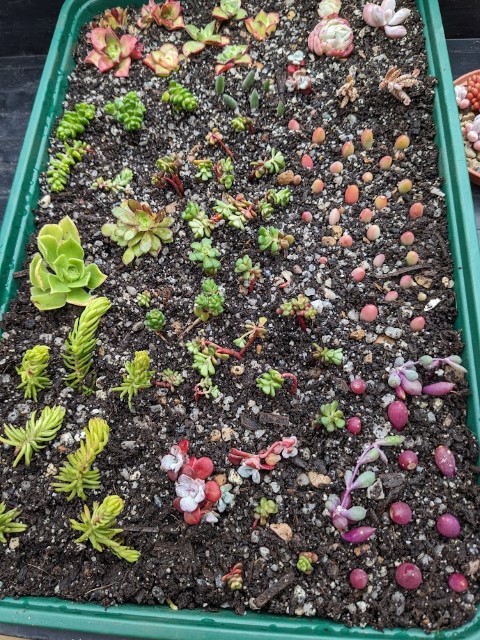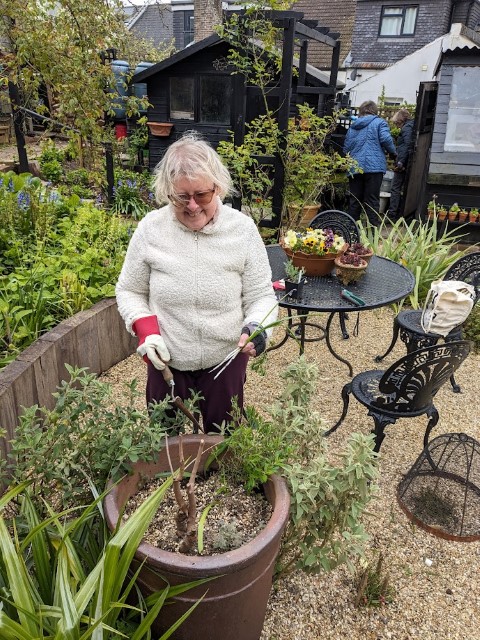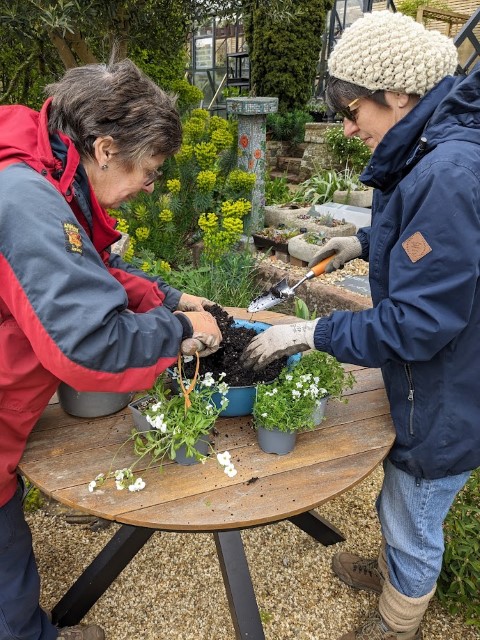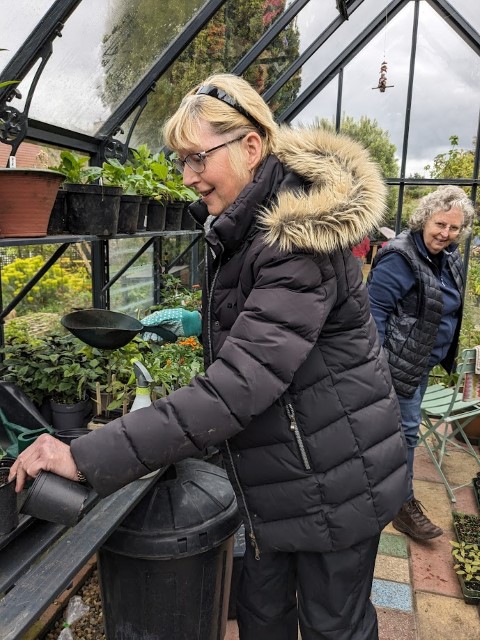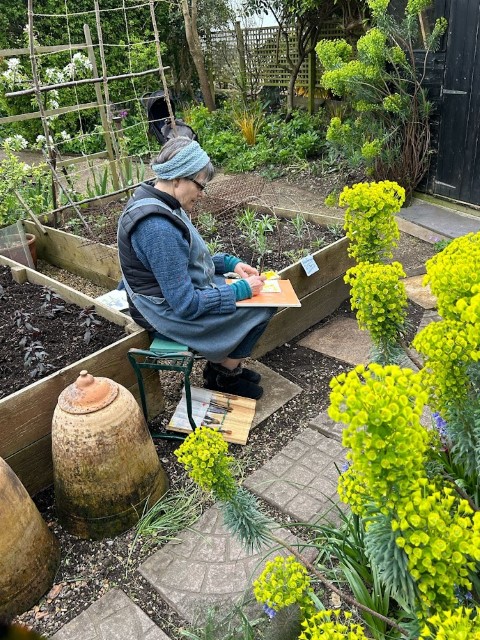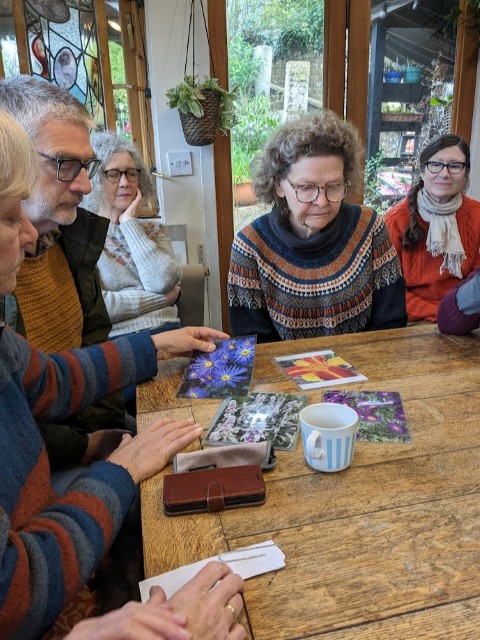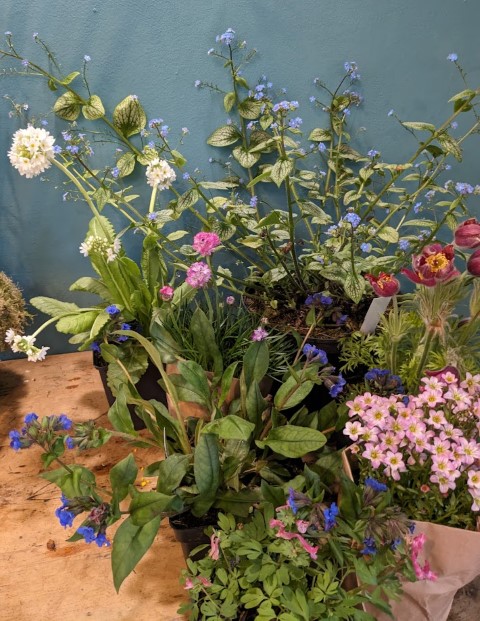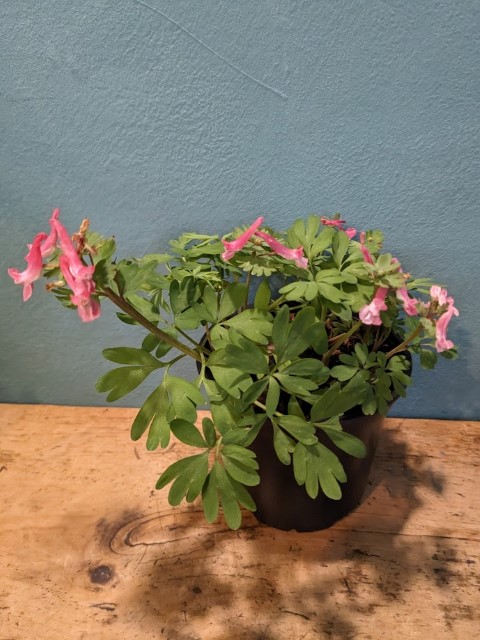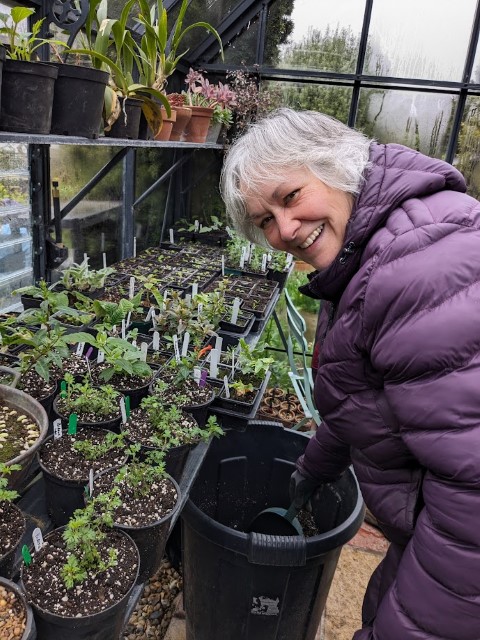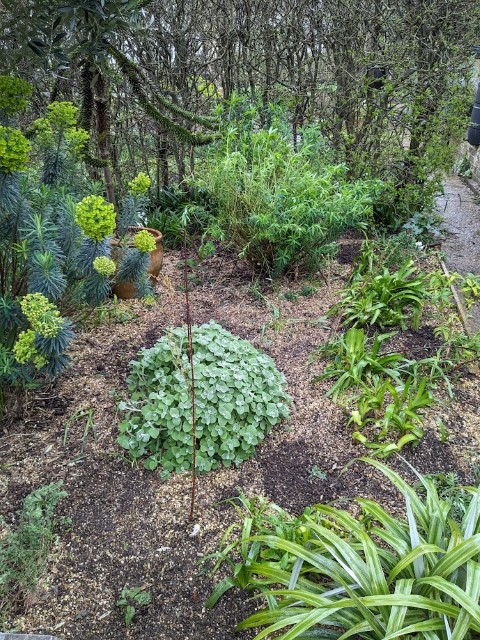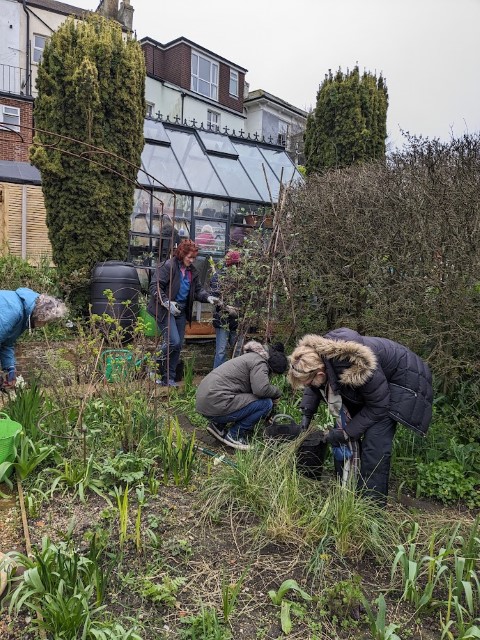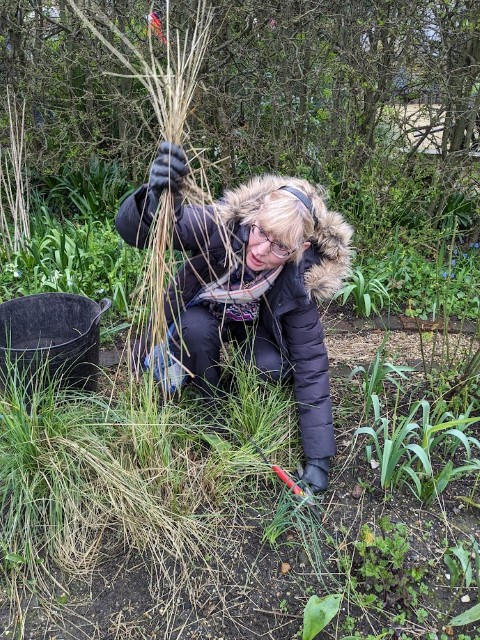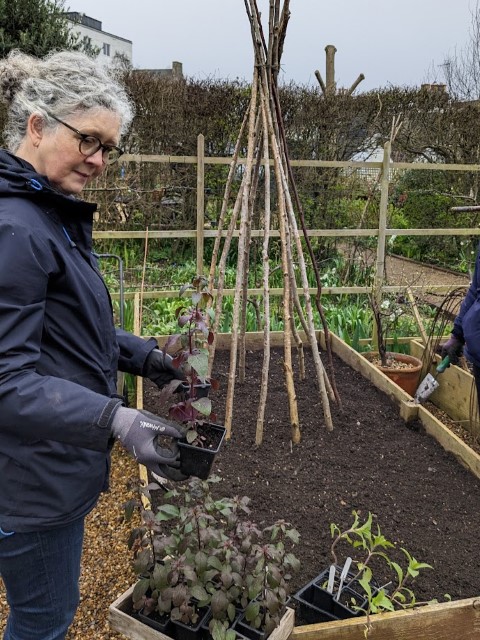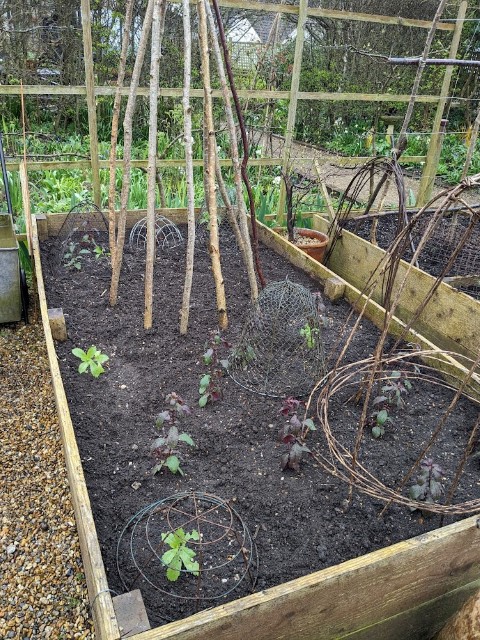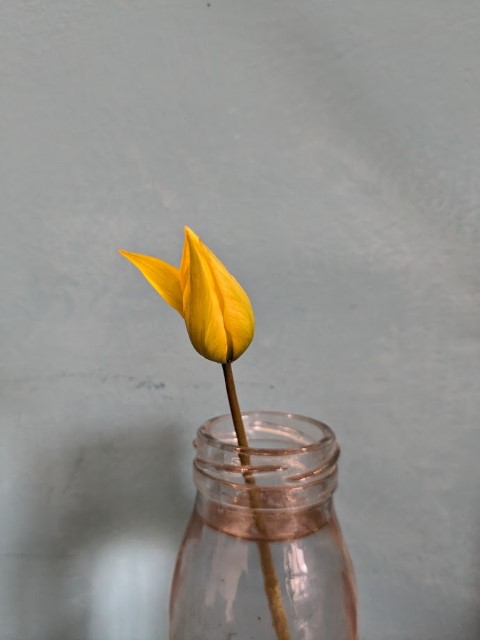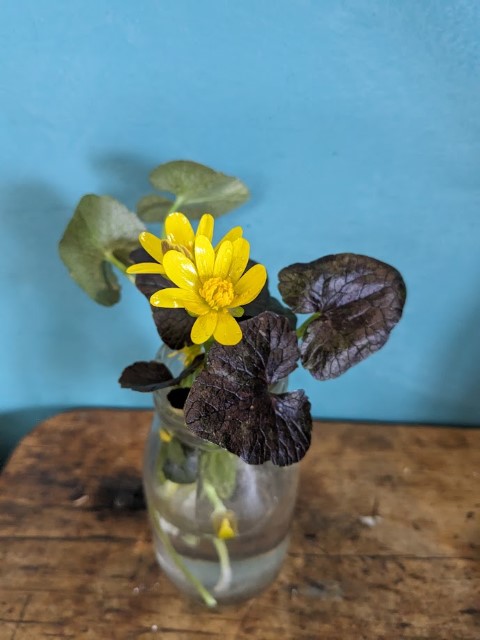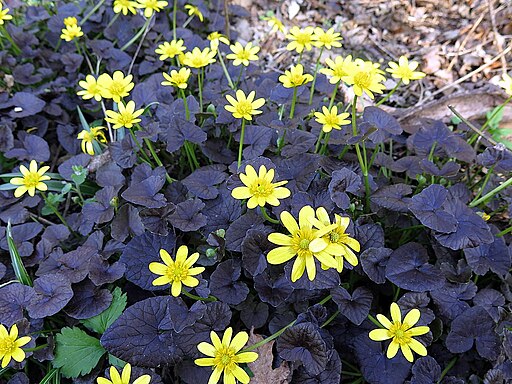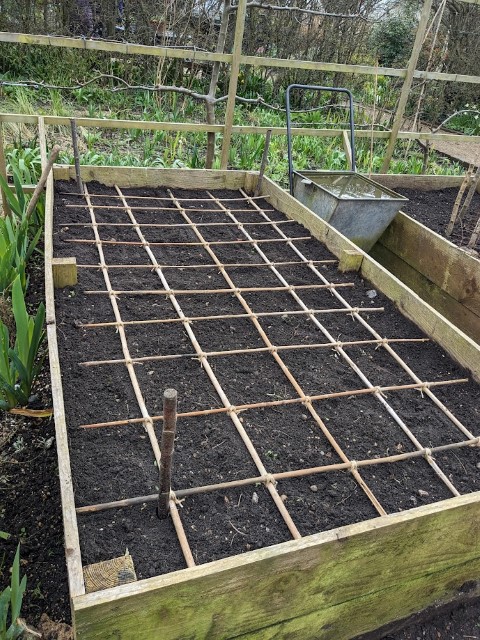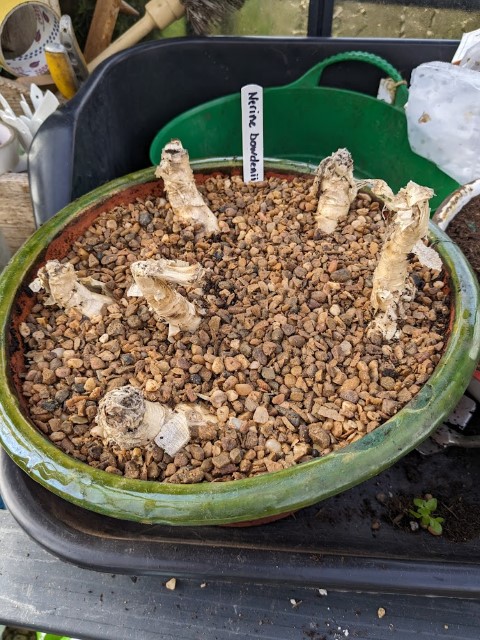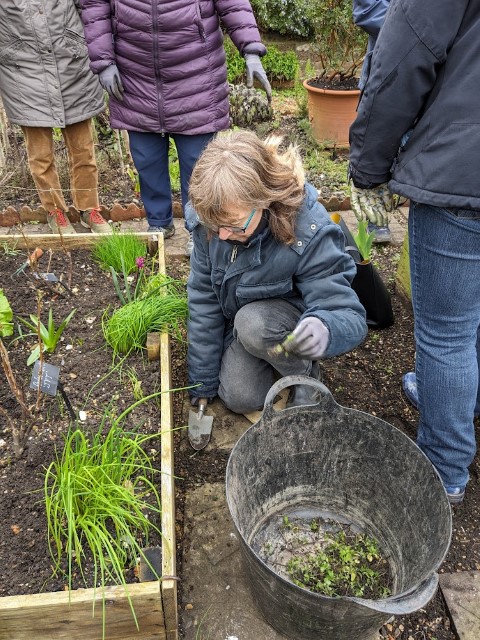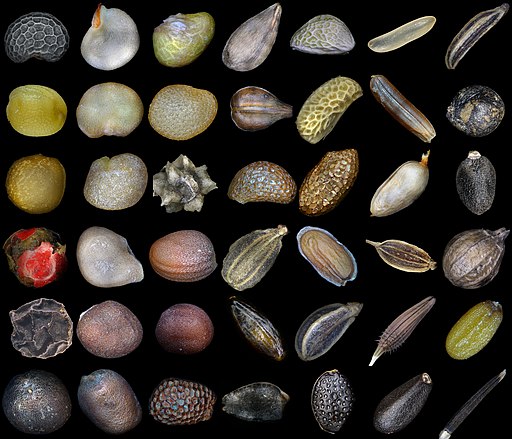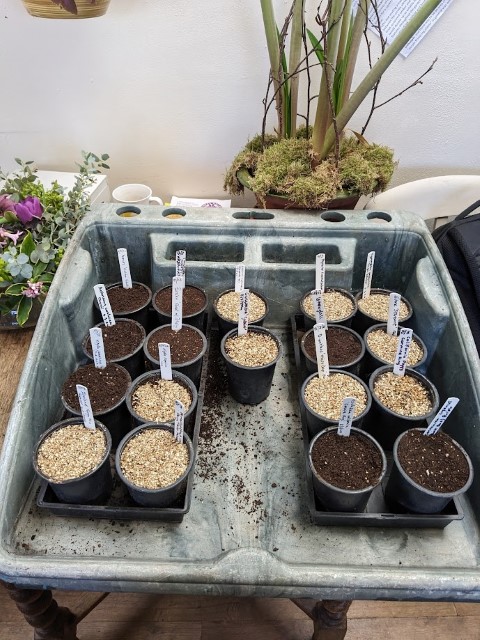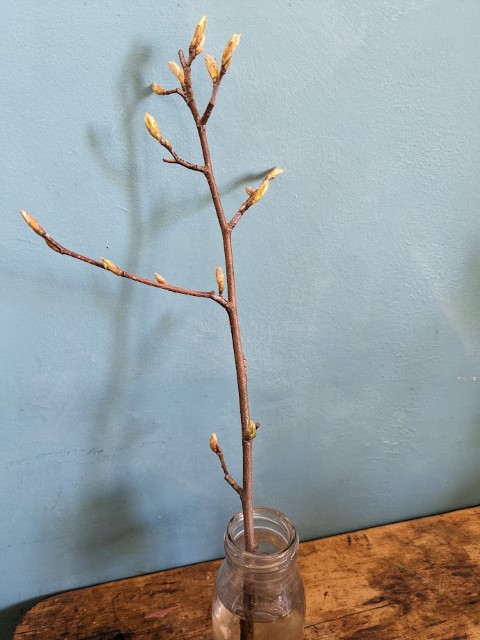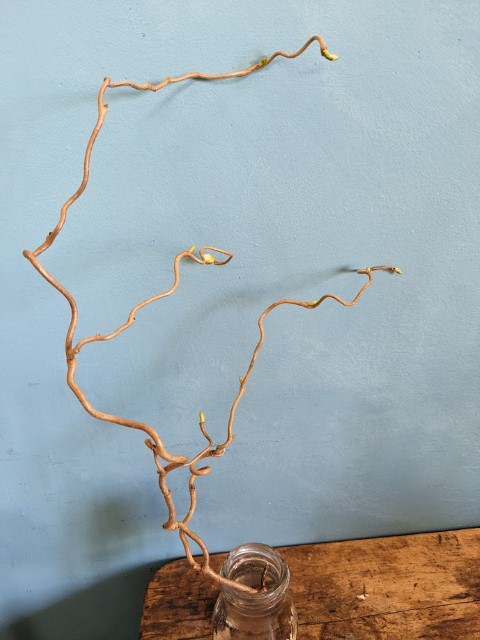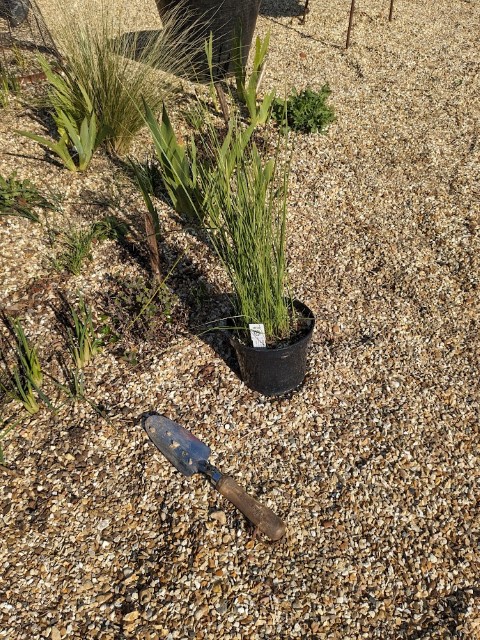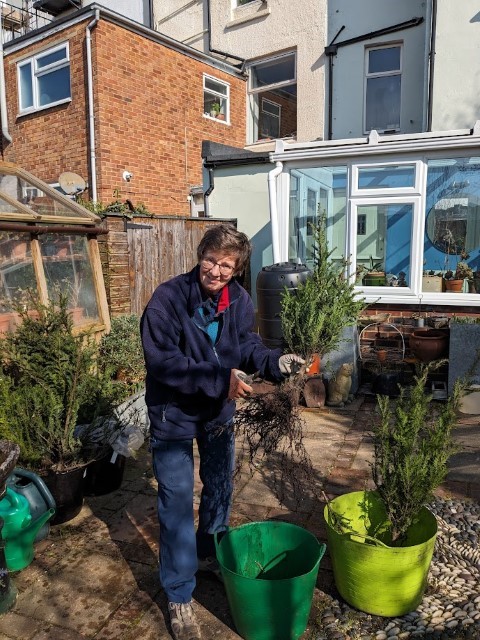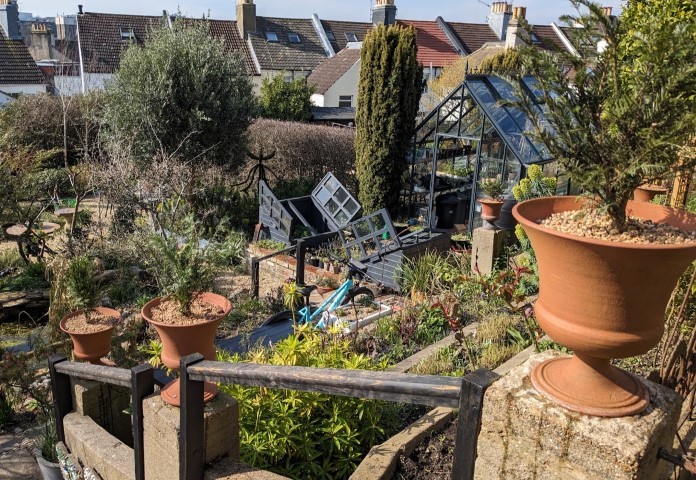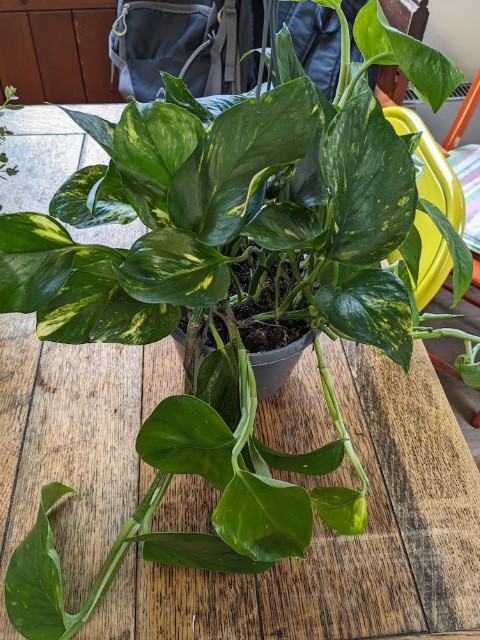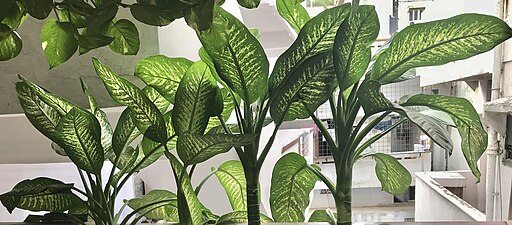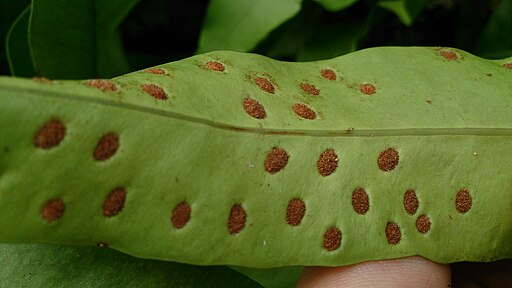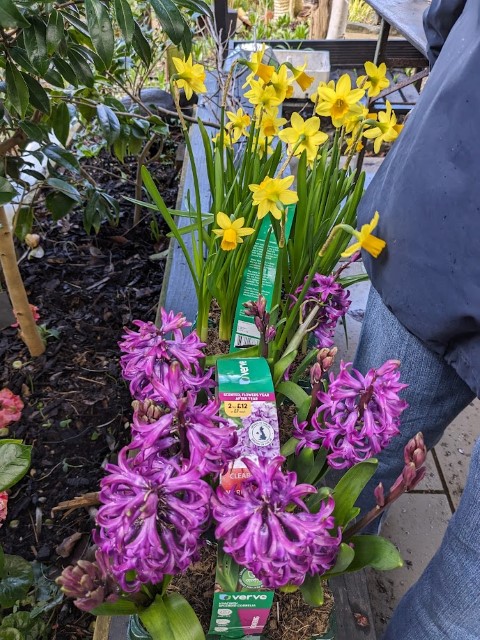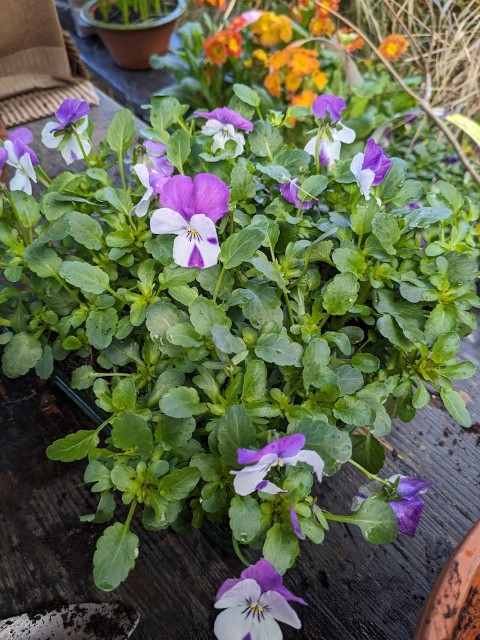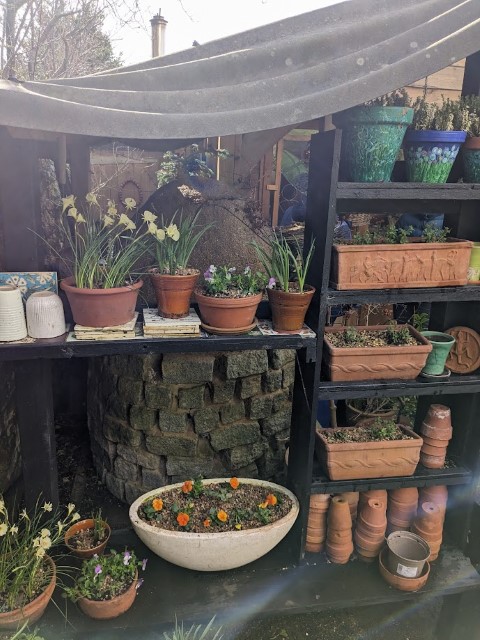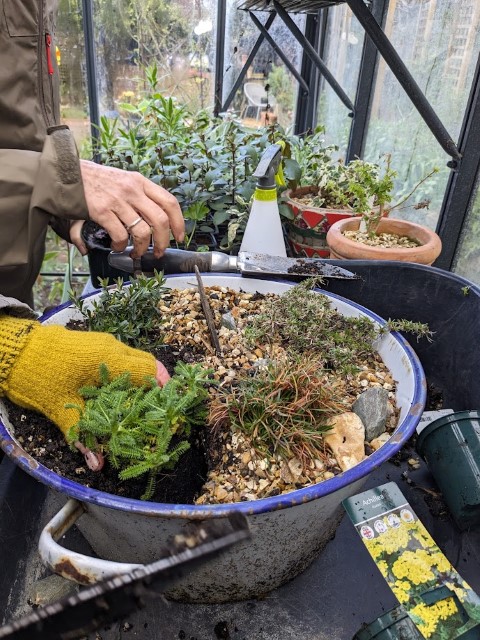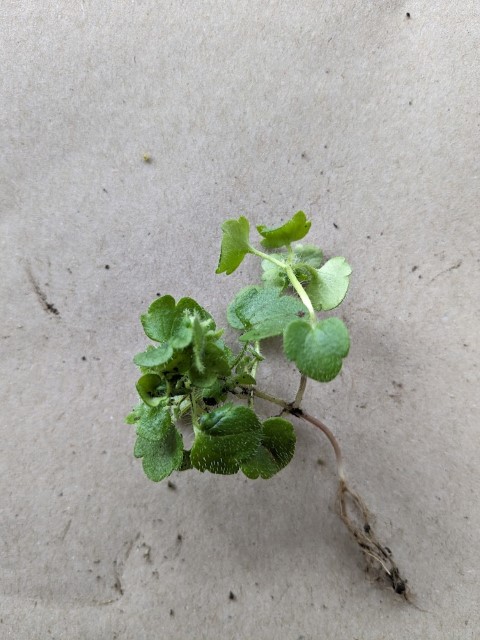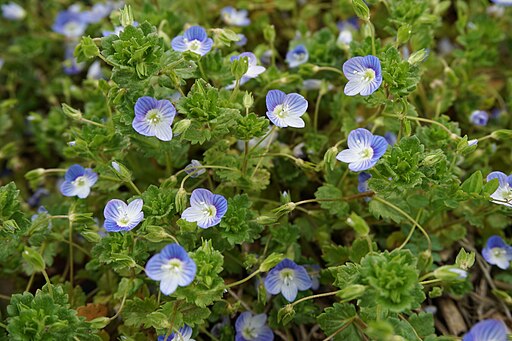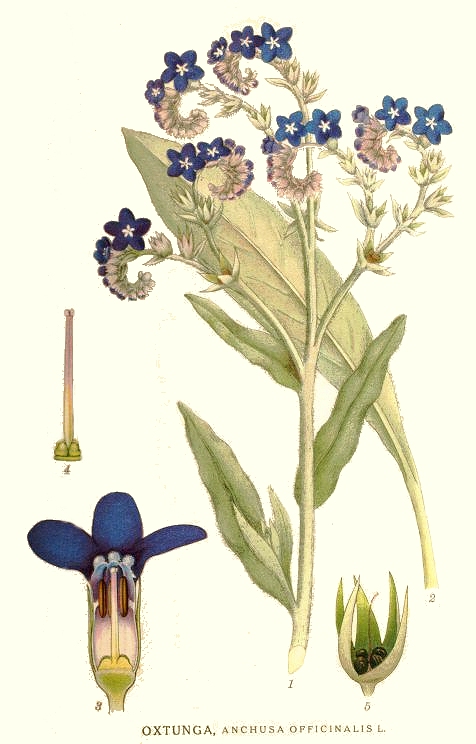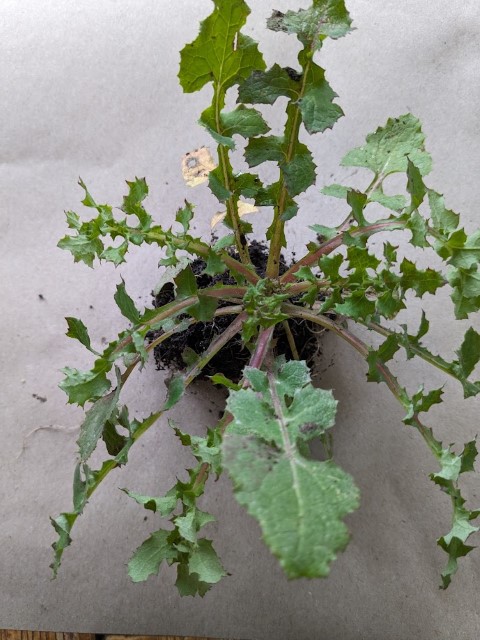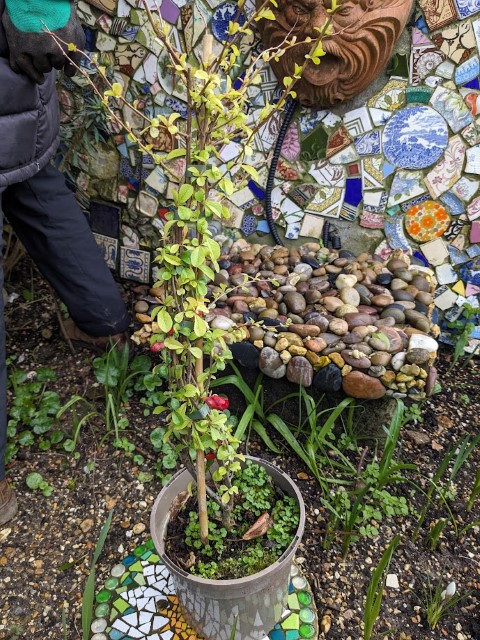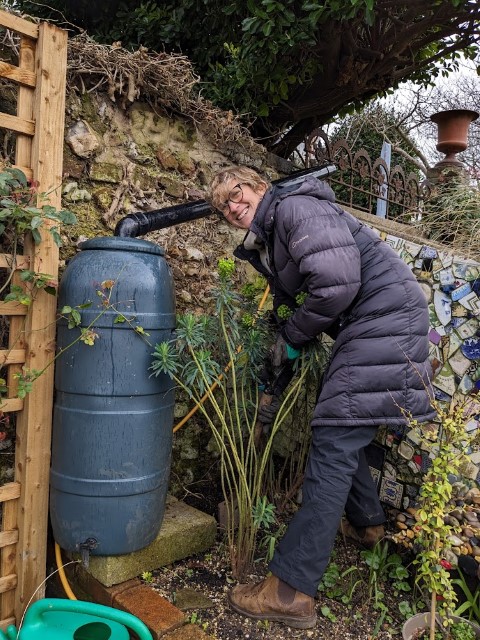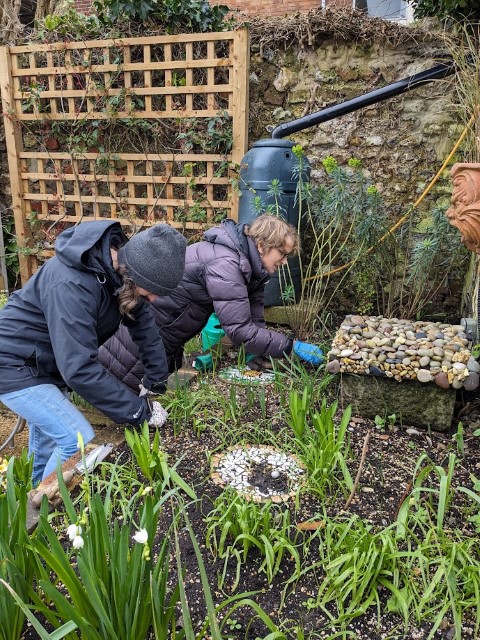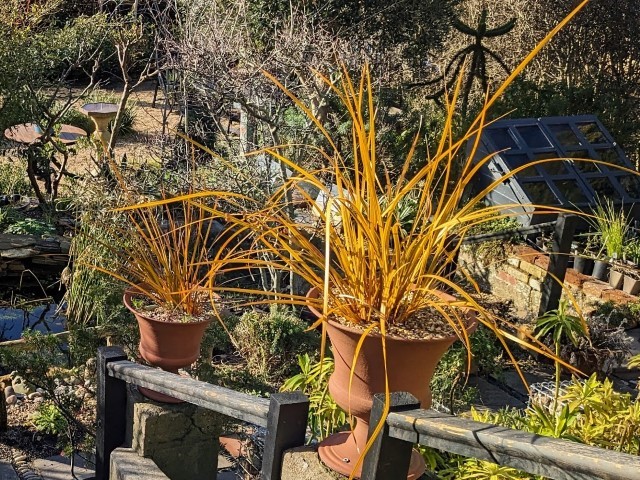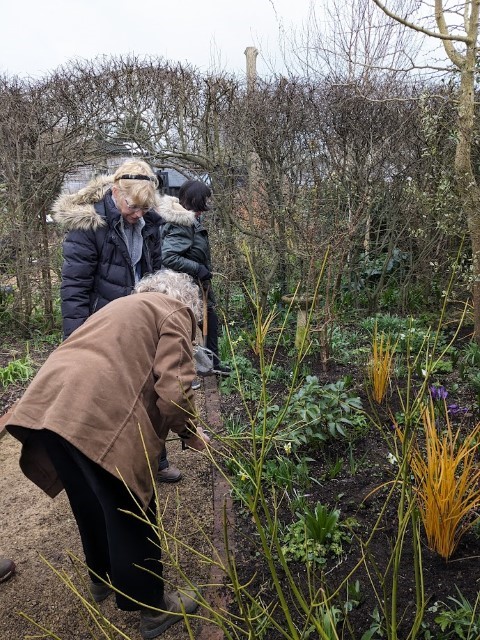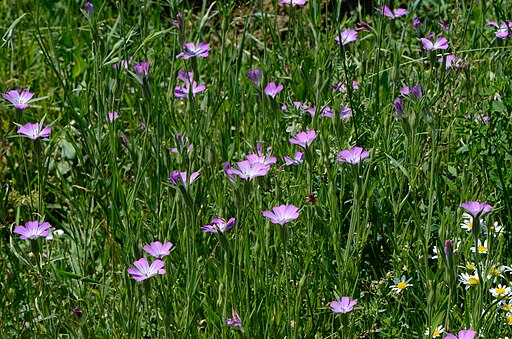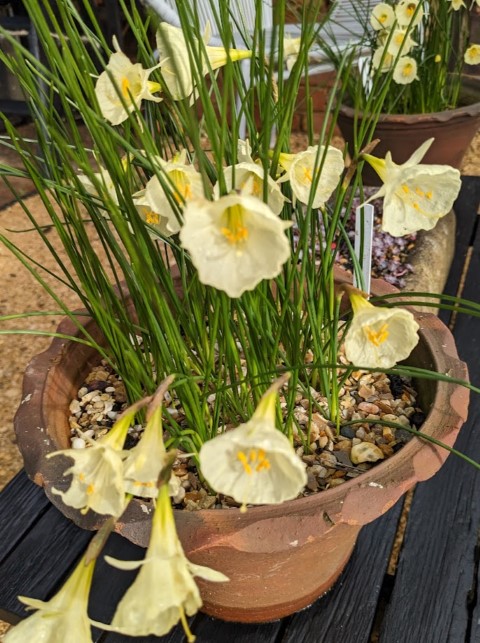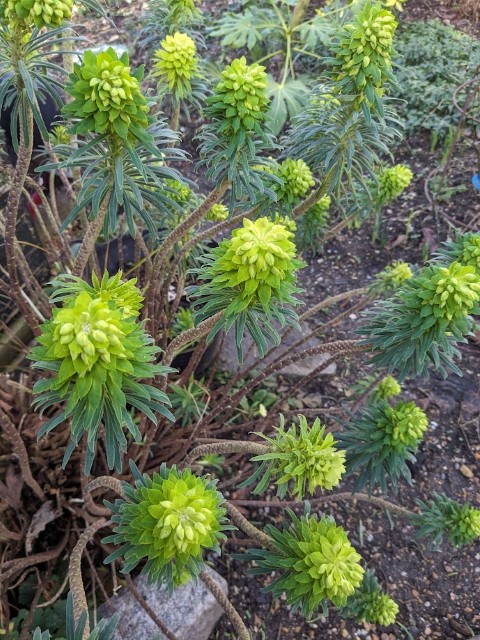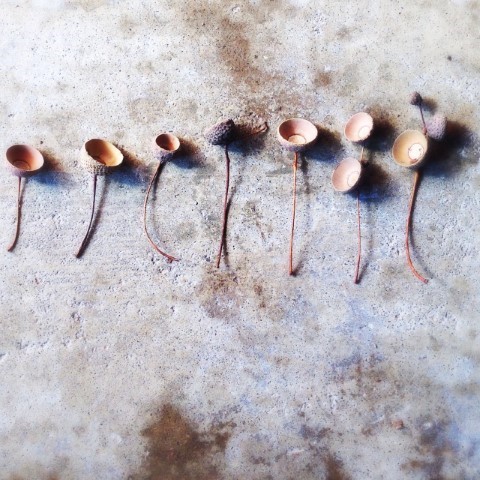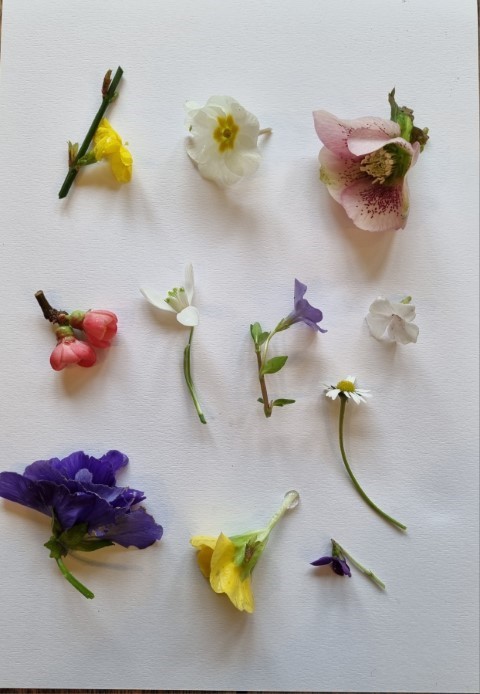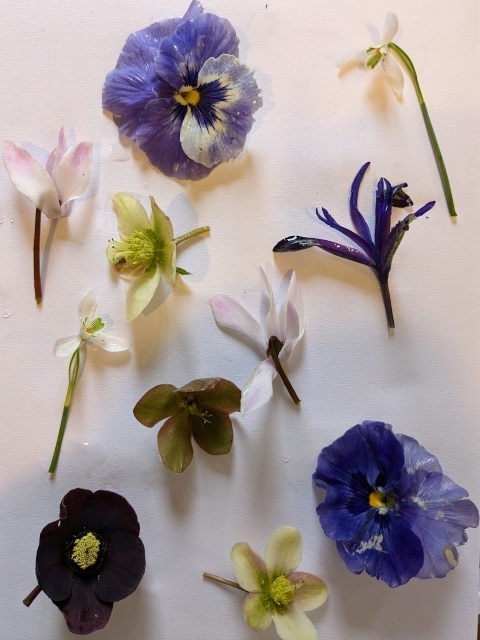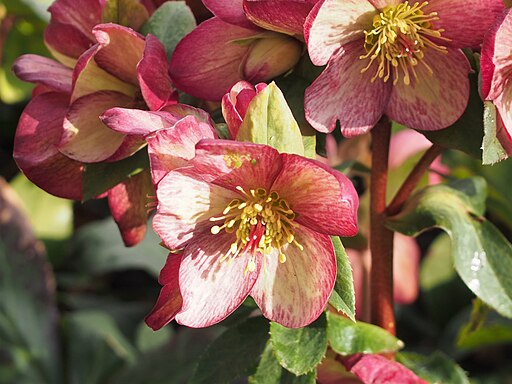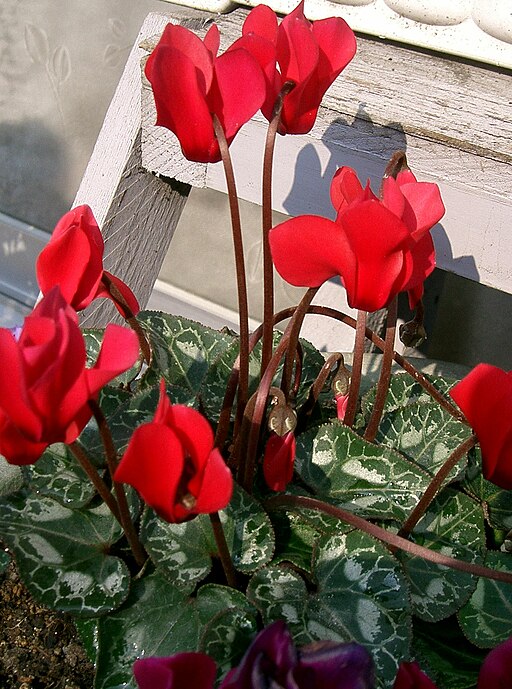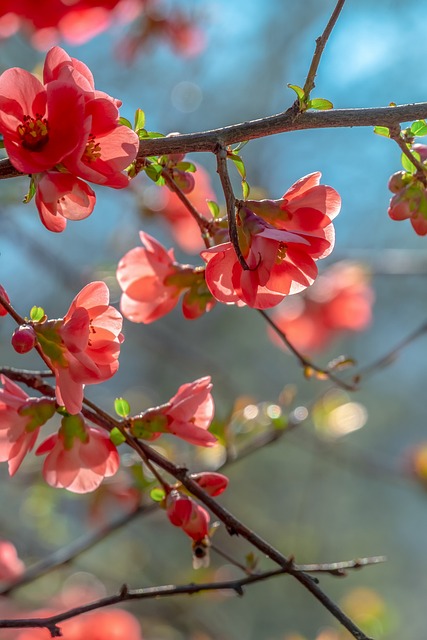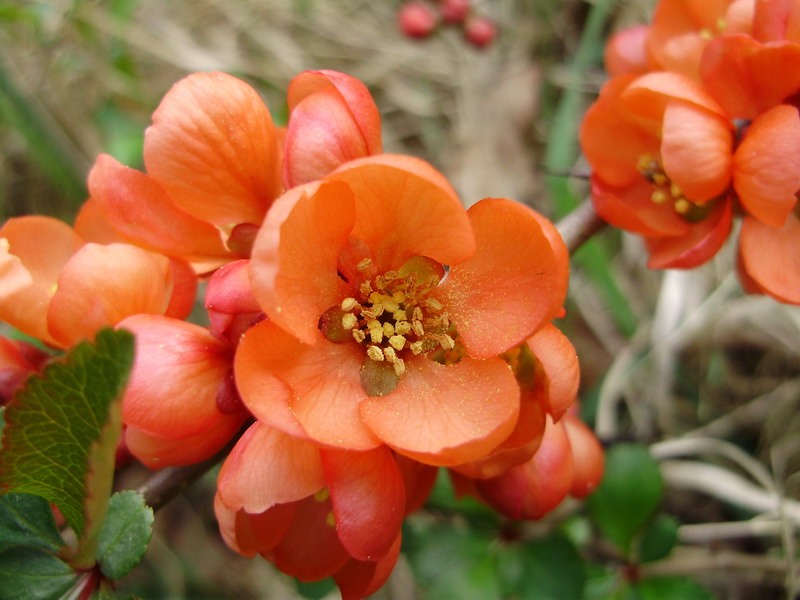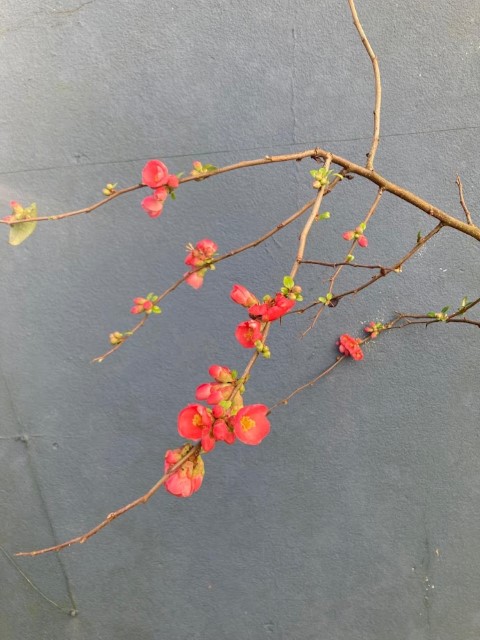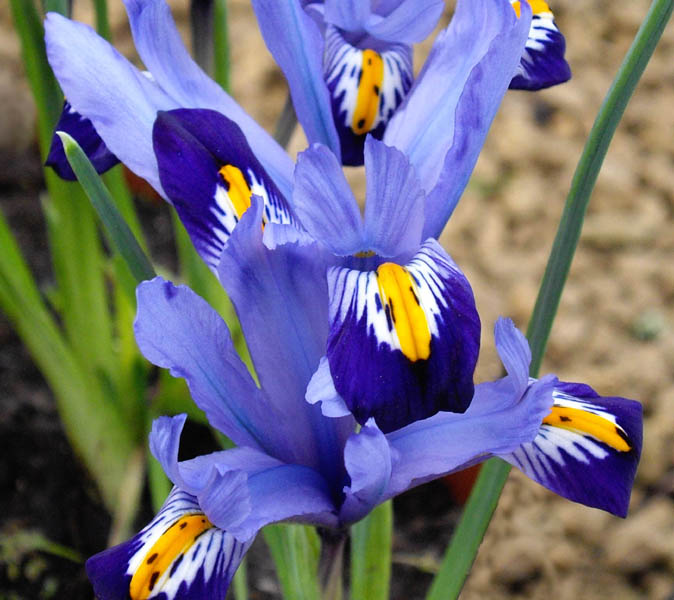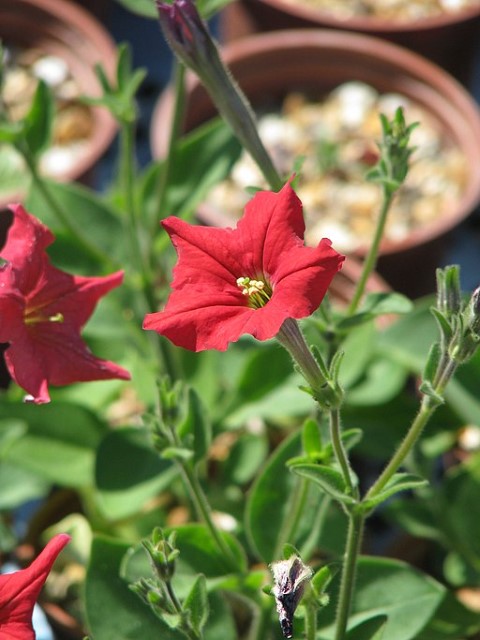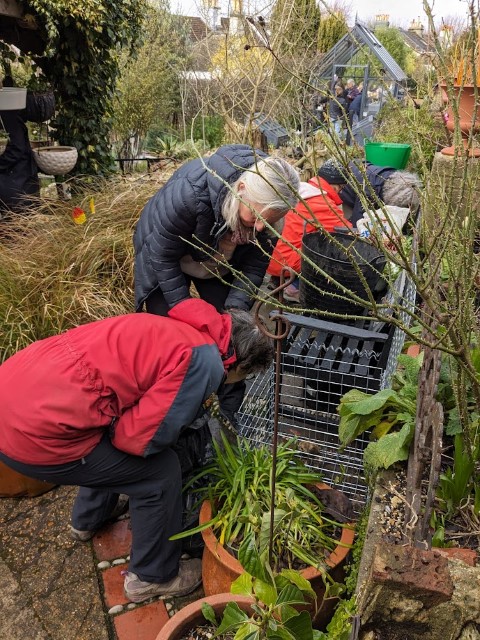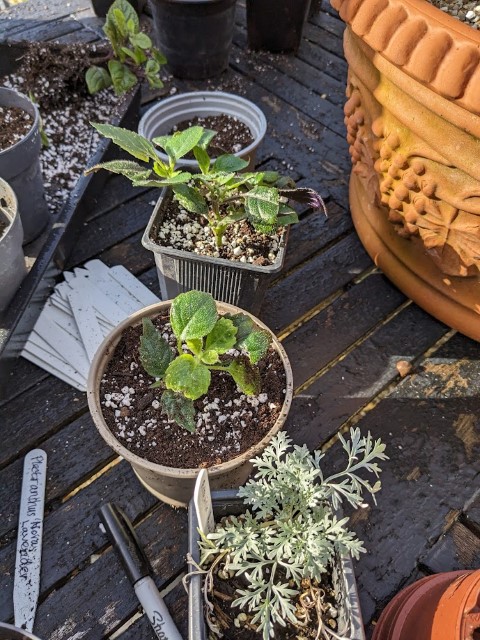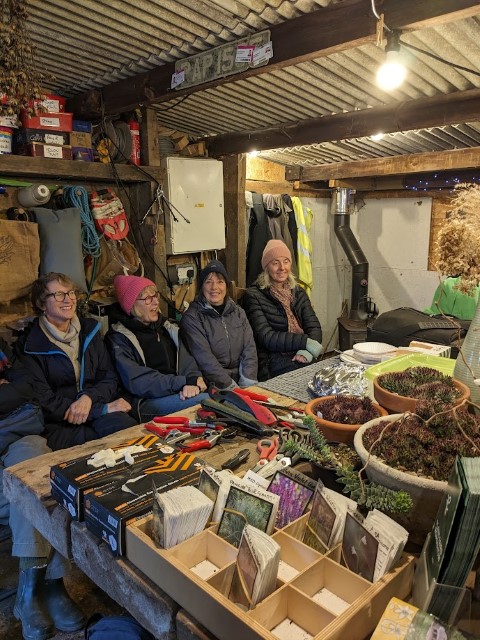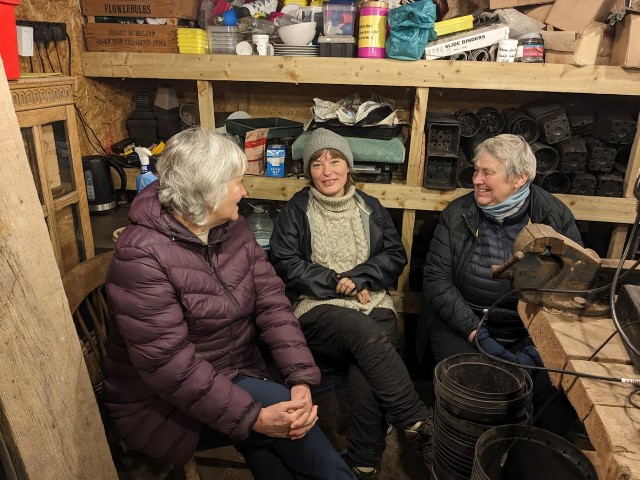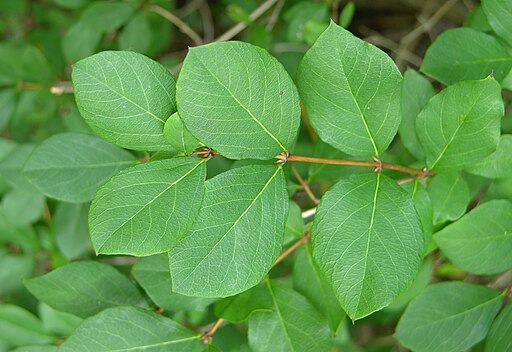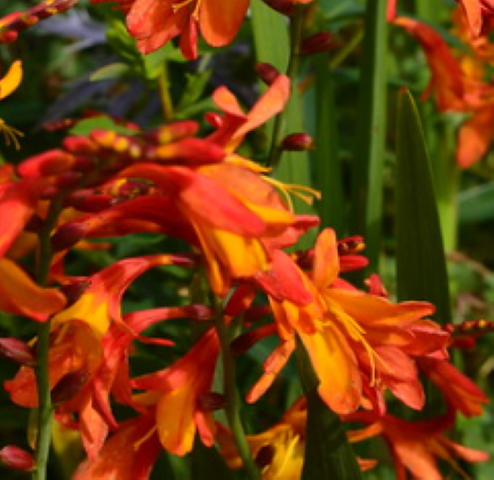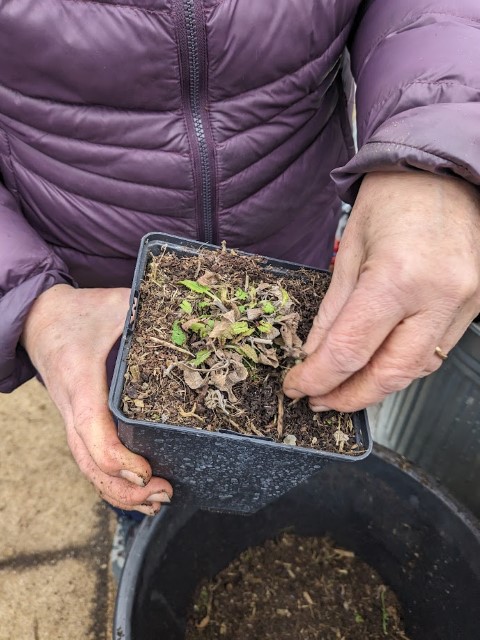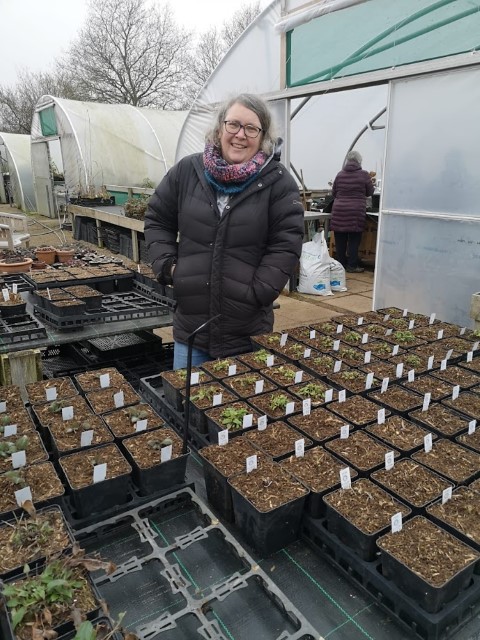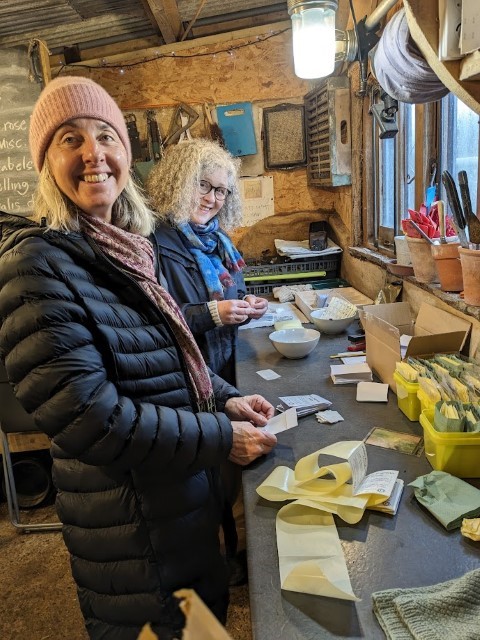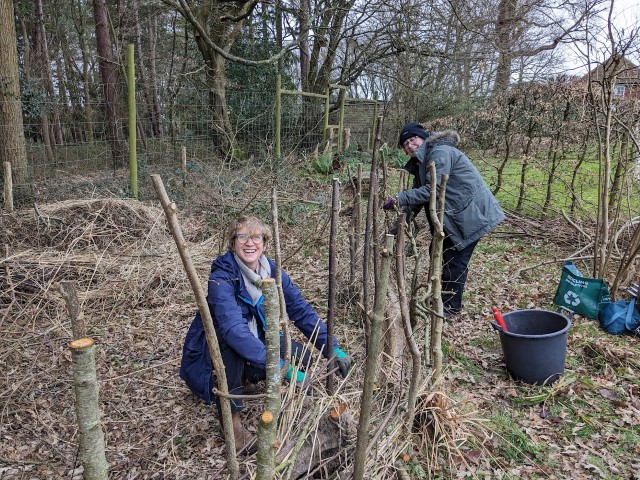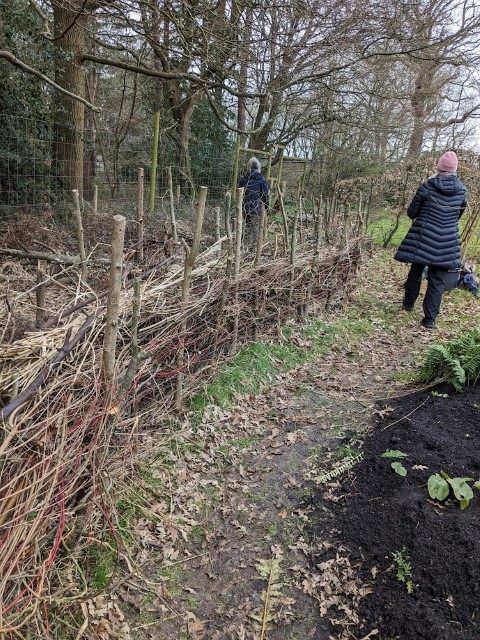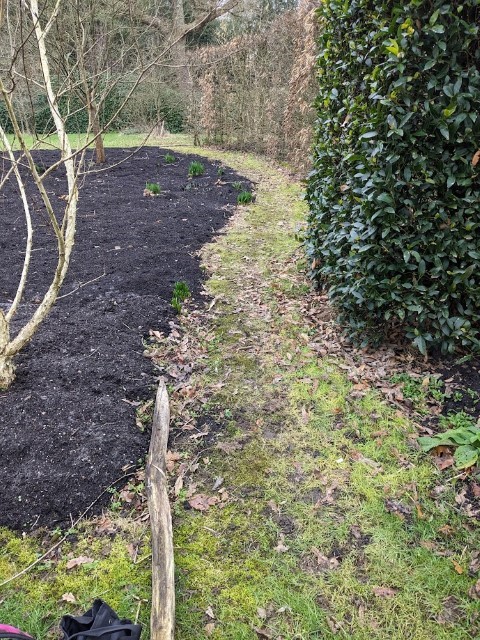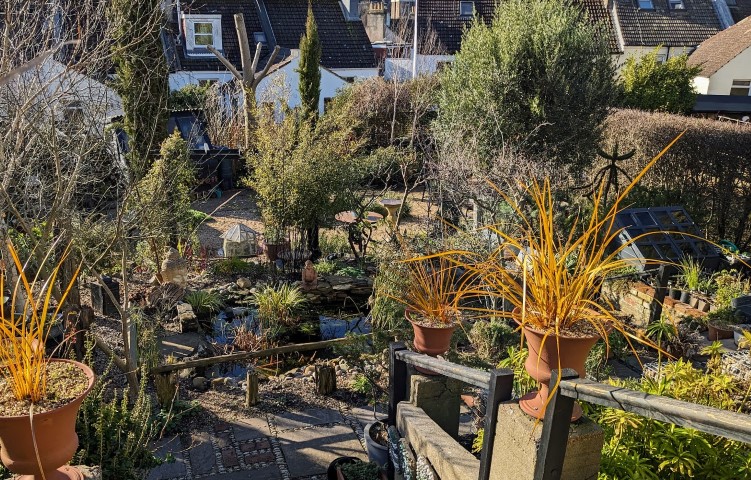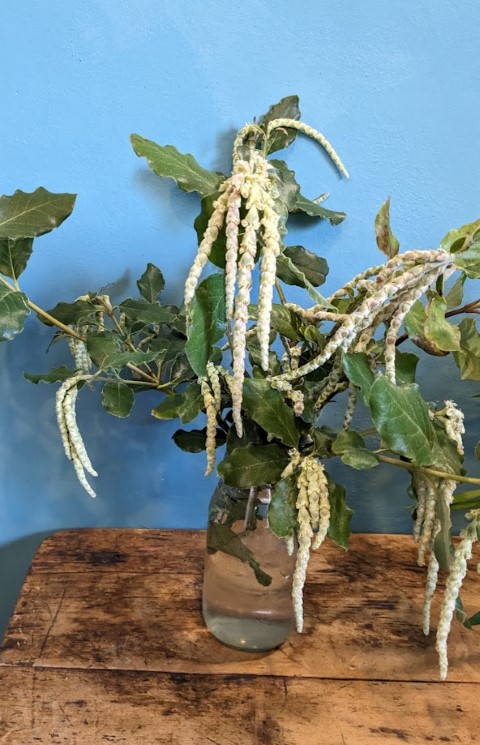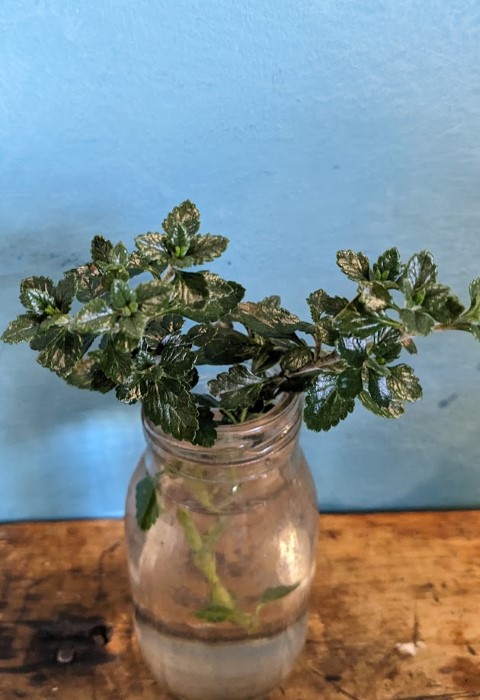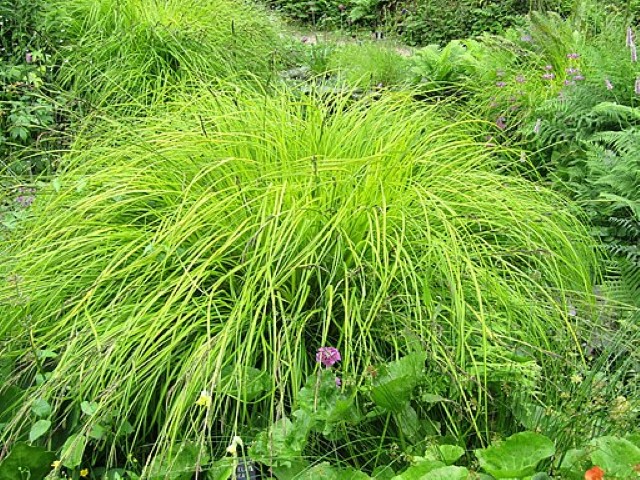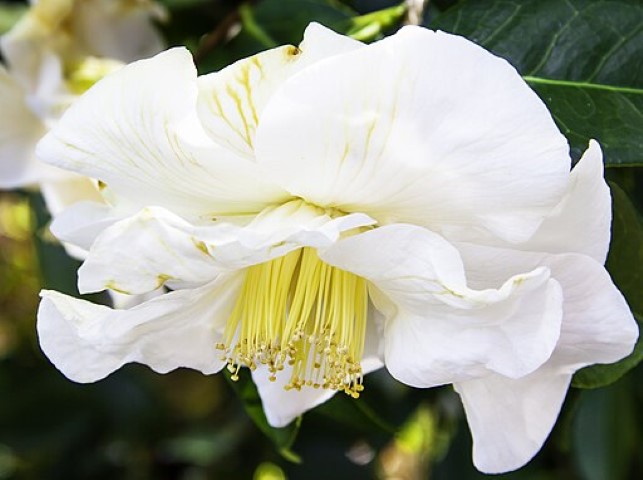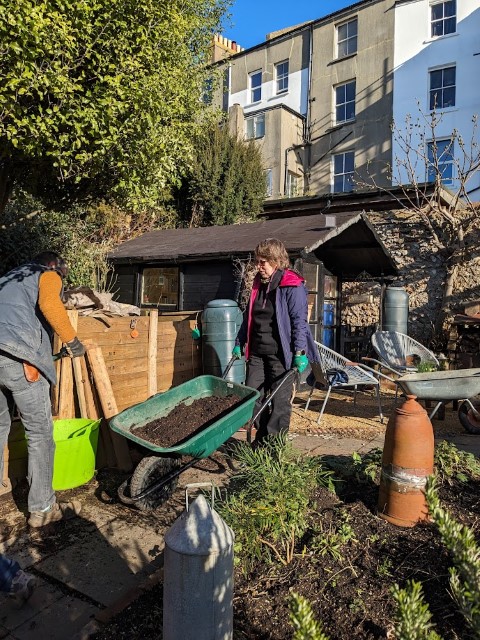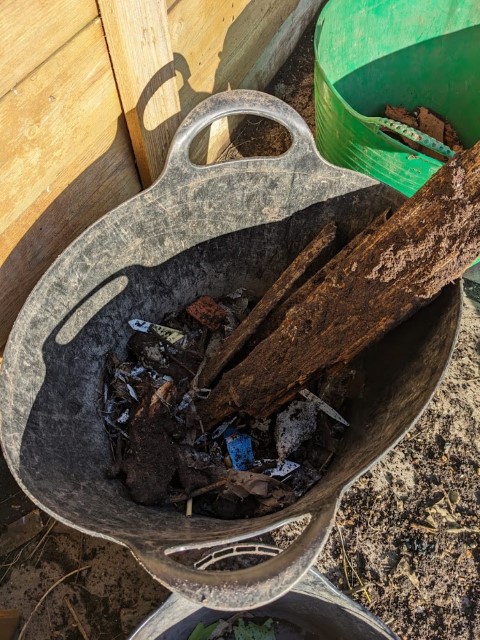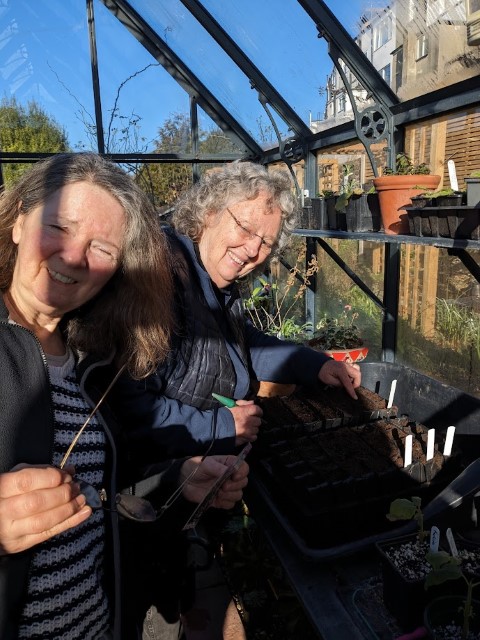


This week at the Garden House, talk turned to planning for summer pots and containers. It’s very tempting to buy on impulse at this time of year (I should know) but you might end up with a mish-mash of colours or too many of one type of plant. It is a good idea to take stock of your stocks (and other plants!) to get an overview of what you have already grown, which fast-growing annuals you could still sow and what you might want to buy to complete your planting plans. Making lists including eventual height and colour, or finding pictures to cut and stick can help sort which plant is destined for which pot. Never fear if this sounds way too organised…some of my best pots have been thrown together with last minute finds at the garden centre and other peoples’ give-aways.
Ident
So, the ident this week is about tender perennials which have been grown for the pots and containers here at GH. These have been grown from cuttings and are a cost-effective way to fill-out and add structure and contrast when planted alongside hardy and half-hardy annuals.
Plectranthus is a genus of about 85 species of flowering plants from the sage family, Lamiaceae, found mostly in southern and tropical Africa and Madagascar where they grow mostly in shady places, often covering the ground under trees. Here are three which are just as happy here…
Plectranthus ciliatus ‘Nico’
(ciliatus – with leaves and petals that are fringed with hairs)
This fast-spreading, easy to grow plant has a sprawling, trailing habit which makes it perfect for pots and the edges of troughs or raised beds but can also be used as ground-cover. It has quite thick, textured leaves which are almost a glossy, dark-green with deep purple veins on the top and dark, reddish-purple underneath. In autumn, long spires of dainty lilac-tinged flowers appear.
Plectranthus are very frost-tender so need to be lifted and placed indoors or in a sheltered spot where the temperature won’t dip below 1-5℃. They are easy to propagate by cuttings as insurance and to increase your stock.
Plectranthus ‘Mona Lavender’ syn. Plectranthus ‘Plepalila’ (pbr)
Commonly known as Swedish ivy, this Plectrathus is more upright than ‘Nico’ with a more “toothed” leaf, less colour on the veining and is more floriferous. It flowers throughout spring and summer with spires of lavender-purple lipped blooms which show that family relationship to sages and salvias.
It likes a moist but well-drained soil and partial shade but will be ok in full sun. Again, it is very tender so lift, cut back and place in a frost-free place…and take cuttings! Ht. 10 – 50cm. RHS AGM🏆
Plectranthus argentatus syn. Coleus argentatus
(argentatus – silver in colour)
I think that this has been reclassified as Coleus – very closely related to Plectranthus. It is sometimes known as silver spurflower and has beautifully soft, furry, silver-grey leaves, hairy, silver stems and purple spikes holding bluish-white flowers from spring to summer. This is a wonderful foil for other plants in summer pots and planters.
Yes – tender, easily propagated and liking the same conditions as the others! Plectranthus make really good house plants too so overwinter on a window sill and maybe keep it there? Ht. up to 1m RHS AGM🏆
Cuphea sp.
This example of the Mexican cigar plant could be species ignea, cyanea or another – there are about 260 varied species in the Cuphea genus – but it will certainly give a fiery boost to your planting schemes. Unusual, tubular flowers in fiery, orange-red contrast against the clear, mid-green of the simple, ovate leaves. It has an upright but open sprawling habit so will tumble slightly over the edges of your pots.
Cuphea loves summer sun and heat, and when grown as an annual, it will bloom nonstop until the first frost. It likes a well-drained soil in sun and is fairly tender so protect from frosts or bring inside and take cuttings.
Bidens ferulifolia ‘Hot and Spicy’
(ferulifolia – with leaves resembling those of the Ferula plant)
Please do not ask what came up when I first googled the name of this plant…I’m still recovering. However, this semi-trailing cultivar is a real zinger. Bidens are from the Asteraceae family, often yellow but come in a range of bright colours, with this relatively new plant having sunburst blooms of vivid orange, near reds and vibrant yellows over small, mid-green , finely divided leaves.
They are often grown as annuals but this can be treated like the other tender perennials – bought in over the winter to protect from frost. Again, this lovely plant is easy to grow from cuttings. Give it well-drained soil in full sun and it should flower from May to October. Ht. 30cm. The plan is to pair it with Dahlia ‘Waltzing Matilda’ for a dramatic ‘hot’ pot.
Salvia ‘Amistad’
This spectacular cultivar has quickly established itself as a favourite among gardeners and garden designers. It is one of the taller salvias with an upright, loosely bushy habit with slightly downy, pointed, bright green leaves. Profuse large, silky, royal-purple, tubular flowers emerge from near-black calyces, held on tall stems of the same dark colour from late summer into autumn.
It likes a sheltered position in full sun with a well-drained but moist soil. It is a herbaceous perennial which means that it will die back in winter but it is fairly tender so protect it from hard frosts and take cuttings to be on the safe side. Ht. 1 – 1.5m RHS AGM🏆
Jobs for the week
Empty some large pots
With all the talk of planting up summer pots there was the small matter of getting some ready. Three large terracotta pots needed to be emptied of their very densely planted bulbs.



Easier said than done! It took teamwork and strength to prise them all out.



Heave-ho…now separate them out to give away…and rest!
Job done.
Start off some Acidanthera and Dahlias
One of the planting plans for pots includes Acidanthera murielae or Abyssinian gladiolus. They grow from corms and these had been saved and kept dry hanging in net bags in the potting shed.
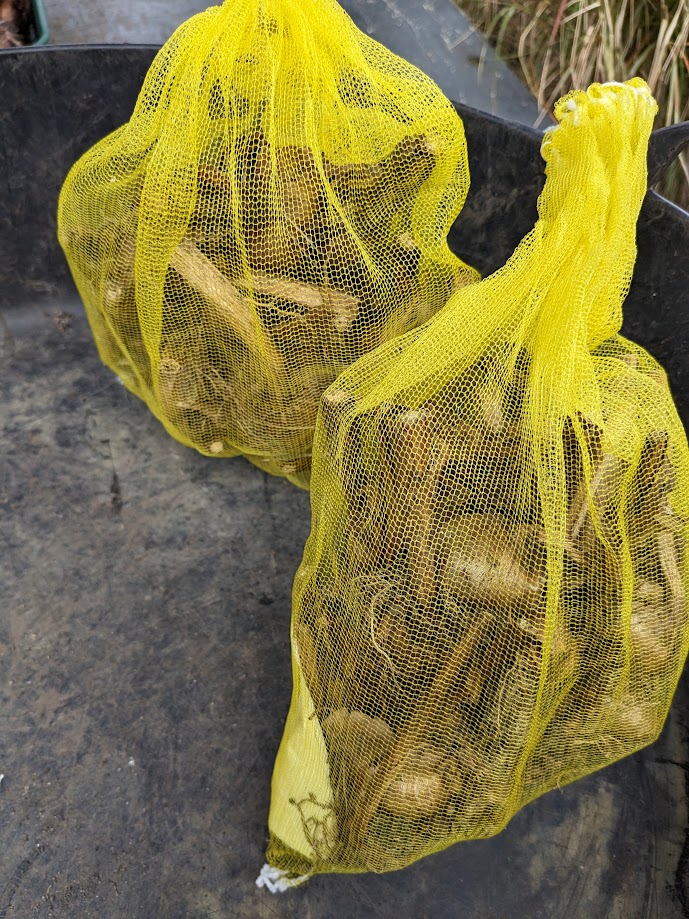

You can start them off growing in trays of gritty compost to save space until they are potted on or planted out.



From corm to beautiful flowering plant in just a few weeks.
The same was done with those ‘Waltzing Matilda’ Dahlias from earlier.
Divide some primroses
Now is a good time to divide primroses and primulas. There were several clumps of Primula vulgaris or native primrose to lift, divide and re-plant on the spring and yellow beds.

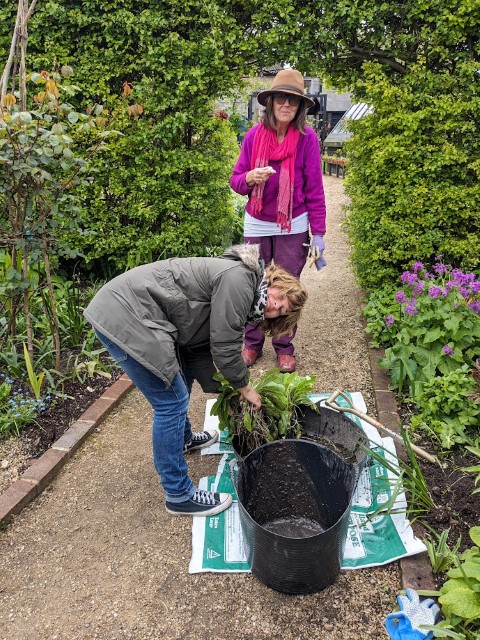



Oops! How big were those clumps? She doesn’t know her own strength!


Plants to give away and a tidy border…win-win.
Lift and divide the Arum italicum
The fabulous Arum italicum has been growing and spreading happily in the bed under the apple tree. It needed to be thinned out a little before it dies back down into the ground for the summer.
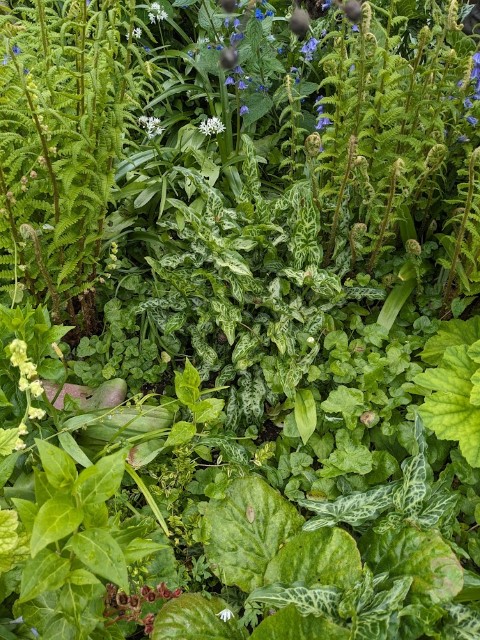


There was a lot of it in there!


Again, plants for all to take home and another tidy bed.
Prick out some seedlings
There was a variety of seedlings to be pricked out in the greenhouse – ‘Moonred’ lettuce, parsley and Dianthus ‘Microchip’ among them. Before anything could be potted up, a new batch of potting mix had to be prepared. This called for a mix of compost and perlite.


A whole bin-full!



The parsley could be pricked out in clumps and is quite robust – other plants need handling carefully (hold by the leaves only!) and were to be pricked out individually.


These seedlings are Scorzonera rosea or red-flowered salsify – gorgeous.
The greenhouse is at bursting point – roll on mid-May!
And finally…Bridge asked me to post this…
Ident please.
See you next time.


